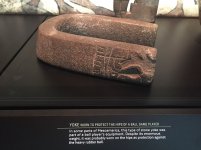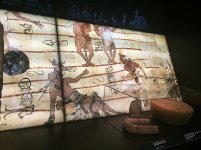I enjoy visiting history museums now and then. Where else can we see such a concentration of lies situated in the same proximity? Naturally could not bypass an opportunity to visit the Royal BC Museum in Victoria. In addition to their every day "natural history" stuff, it had a featured exhibition which was:
There was a whole bunch of Mayan exhibits out there, but here are a few worth being mentioned on this blog.
Mayan Ball Game
The Mesoamerican ballgame was a sport with ritual associations played since 1400 BC by the pre-Columbian people of Ancient Mesoamerica. The sport had different versions in different places during the millennia, and a newer more modern version of the game, ulama, is still played in a few places by the indigenous population.
- The rules of the game are not known, but judging from its descendant, ulama, they were probably similar to racquetball, where the aim is to keep the ball in play. The stone ballcourt goals are a late addition to the game.
- In the most common theory of the game, the players struck the ball with their hips, although some versions allowed the use of forearms, rackets, bats, or handstones. The ball was made of solid rubber and weighed as much as 4 kg (9 lbs), and sizes differed greatly over time or according to the version played.
- Mesoamerican ballgame - Wikipedia
- Mesoamerican rubber balls - Wikipedia
The Ball
While the narrative tells us that the max weight of the ball was like 9 pounds, I have my reasons to question that. Below you can see a picture, of the authentic game ball. I did not see anything saying that it was a replica, therefore we have to consider it an authentic one. As you can see, visitors were allowed to stick their hands inside the plastic glass box and pick it up. Well this thing was at least 10 inches wide and probably weighed like 15 pounds. It definitely was rubbery to the touch, but I am not sure it was capable of any serious jumping. It felt like it was a rubberized cannon ball. One thing for sure, I would get the hell out of the way if this thing was coming my way.If you wanna have a little laugh, watch what it feels like to kick a medicine ball of similar size:
This is most definitely a good show for tourists, but how much in common this show has with the actual ancient ball game, I do not know.
The Yoke
The Yoke did not appear to be big enough to go around hips, but hey, that is what the narrative tells us. Them players were running around with a 50 pound dumb bell on their hips while kicking a 15 pound ball around. I certainly hope this is not how this "yoke" was worn...
I like how the Yoke in the video above was made of diorite. May be she knows how to make one of those too?
Metal Pipe

Once again, the label above states nothing pertaining to the below altar being some sort of a replica, hence we assume the altar is authentic.
I am not sure what Mayans needed a metal pipe inside of one of their altars for, but what do I know?
- The emergence of metallurgy in pre-Columbian Mesoamerica occurred relatively late in the region's history, with distinctive works of metal apparent in West Mexico by roughly AD 800, and perhaps as early as AD 600. Metallurgical techniques likely diffused northward from regions in Central or South America via maritime trade routes; recipients of these metallurgical technologies apparently exploited a wide range of material, including alloys of copper-silver, copper-arsenic, copper-tin and copper-arsenic-tin.
- West Mexican smiths worked primarily in copper during the initial period, with some low-arsenic alloys, as well as occasional employment of silver and gold. Lost-wax cast bells were introduced from lower Central America and Colombia during this phase, along with several classes of cold-worked ornaments and hand tools, such as needles and tweezers. The prototypes for these small, often utilitarian items appear rooted in southern Ecuador and northern Peru.[8]Small copper rings, generally found in burial contexts, are also common to Ecuador and Western Mexico and are abundant during this phase.
- Excavated assemblages from the initial phase indicate that lost-wax cast bells also occupied a substantial portion of West Mexican artisans' efforts. Unlike similar bells recovered from coastal Ecuador, West Mexican bells were cast, rather than worked, metal. Typically composed of a smooth, suspended metal shell encasing an interior clapper, the West Mexican bells were generally fashioned from copper alloys and bore particular resemblance to bells made in Colombia, Panama and Costa Rica.
No pipe touching was allowed, but it sure was no gold, or copper. It appeared to have some light rust about it, and appeared to have the same altar material inside of it. You judge for yourself, but it looked like a piece of an iron pipe. May be iron piping was required for ancient Mayan altars, I do not know. What I do know, is that the exhibit did not mention the pipe, or the material the said pipe was made of.
Pretty sure, there will be some plausible explanation for the existence of this pipe, but what else is new?
Stone Hammers
The general natural history portion of the museum was located on the third floor, if I remember correctly, while the Mayan exhibit was hosted on the second. The third floor contained your average natural history "local area" related stuff. Several wonderful stone hammers attracted my attention.I apologize beforehand, but some of these hammers looked like no hammers at all.
Hand Mauls
Stone Hammer Heads
KD: I will say it how I see it. The curators of the Royal BS Museum are full of shit. This is the general problem we face as a society. We do not question what we are shown, we simply believe it. May be it is about time we changed our approach. As in SHOW US:
- Show us how to play this game with a rubberized cannon ball, while wearing a stone horseshoe in your crutch.
- Show us how to split a log using this specific hammer setup.
- Show us how they were making these "hammers" out of granite and diorite, or these ones here.



